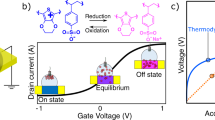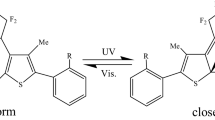Abstract
The purpose of construction of ion potential diagrams is to facilitate the description of systems in which ionic species are mobile. These diagrams depict qualitatively the spatial dependence of the potential energy for mobile ions in a way similar to band diagrams for electrons. We specify and explain what types of experimental data are needed to construct these diagrams. We construct such diagrams for five layer electrochromic devices in which both optically active electrodes are oxides, capable of reversible lithium ion intercalation. We consider the systems at open circuit and under bias. We compare the behaviour of several electrochromic oxides with respect to intercalation and deintercalation reactions. On the basis of the diagrams we discuss electrode stability and switching time in electrochromic devices. Possible novel electrode materials, in terms of their electrical behaviour, are discussed.
Similar content being viewed by others
6. References
J.F. Guillemoles and D. Cahen, Cryst. Res Technol.31, 147 (1996).
J.F. Guillemoles and D. Cahen, Ionics2, 143 (1996).
S.K. Deb, Philos. Mag.27 801 (1983); C.G. Granqvist, “Handbook of inorganic electrochromic materials”, Elsevier, Amsterdam, 1995; Solar En. Mater. Solar Cells39, 2 (1995), special issue on electrochromics, B. Scrosati, ed.
R.B. Goldner et. al., Appl. Phys. Lett.62, 1699 (1993).
A.M. Andersson et al., Appl. Opt.28, 3295 (1989).
M. Green and K. Kang, Displays, October 1988, p. 166.
F.M. Michalak, J.R. Owen, Solid State Ionics86, 965 (1996) and in this issue.
J.R. Akrige and M. Balkanski, “Solid State Microbatteries” (NATO ASI Series B) Plenum Press NY 1990.
H. Reiss, J. Phys. Chem.89, 3783 (1985).
S. Hashimoto, H. Matsuoka, J. Electrochem. Soc.138, 2403 (1991).
S. Radhakrisnan, S. Unde, A.B. Mandale, Solid State Ionics48, 268 (1997).
S.J. Golden, B.C.H. Steele, Solid State Ionics,28–30, 1733 (1987).
R.B. Goldner et al., Solid State Ionics70/71, 613 (1994).
T. Brousse and D.M. Schleich, Ionics, to be published (Proc. 4th Euroconf. Solid State Ionics); R.A. Huggins,ibidem; Y. Idota, M. Mishima, M. Miyaki, T. Kubota, T. Miyasaka, Eur. Pat. Appl. 651450 Al 950503.
S.K. Mohapatra, S. Wagner, J. Electrochem. Soc.125, 1603 (1978).
M. Green, Thin Solid Films50, 145 (1978).
J. Nagai, T. Kamimori, Jpn. J. Appl. Phys.22, 681 (1983).
J.-G. Zhang, C.E. Tracy, D.K. Benson, S.K. Deb J. Mater. Res.8, 2649 (1993).
C. Ho, I.D. Raistrick, R.A. Huggins, J. Electrochem. Soc.127, 343 (1980).
M. Leibovitch, L. Kronik, E. Fefer, V. Korobov, and Y. Shapira, Appl. Phys. Lett.65, 457 (1995).
D.L. Kronik, L. Burstein, M. Leibovich, Y. Shapira, D. Gal, E. Moons, J. Beier, G. Hodes, D. Cahen, D. Hariskos, R. Klenk, H. W. Schock, Appl. Phys. Lett.67, 1405 (1995).
D. Scherson, W. Ekardt, H. Gerischer, J. Phys. Chem.89, 554 (1985).
Q. Zhong, J. R. Dahn, K. Colbow, Phys. Rev.B 46, 2554 (1992).
C. Julien, L. El-Farh, M. Balkanski, O.M. Hussain, G.A. Nazri, Appl. Surface Science65/66, 325 (1993).
A. Gorenstein, J. Scarminio, A. Lourenço, Solid State Ionics86–88, 977 (1996).
C.G. Granqvist “Handbook of inorganic electrochromic materials”, Elsevier, 1995, p. 394–395.
C.G. Granqvist “Handbook of inorganic electrochromic materials”, (Elsevier 1995) page 310–312.
F. Decker, R. Pileggi, S. Passerini, B. Scrosati, J. Electrochem. Soc.138, 3182 (1991).
J. Molenda, A. Stoklosa, T. Bak, Solid State Ionics36, 53 (1989).
Author information
Authors and Affiliations
Rights and permissions
About this article
Cite this article
Varsano, F., Masetti, E., Guillemoles, J.F. et al. Ion potential diagrams as guidelines for stability and performance of electrochromic devices. Ionics 3, 420–426 (1997). https://doi.org/10.1007/BF02375719
Received:
Accepted:
Issue Date:
DOI: https://doi.org/10.1007/BF02375719




